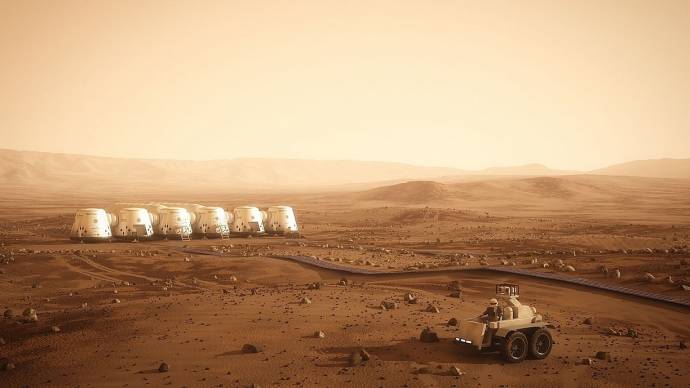|
Mars thread
|
|
| apenpaap | Date: Wednesday, 17.10.2012, 10:47 | Message # 31 |
 World Builder
Group: Users
 Antarctica
Antarctica
Messages: 1063
Status: Offline
| The best thing I can see Mars One doing is failing, but making more people interested in space. The worst thing I can see them doing is failing, but killing some poor saps in the process. There's just no way they're actually going to do it (especially with the timeframe they've set; 2023 is only nine years from now), but it might just spark the fancy of people who watch tv.
I occasionally stream at http://www.twitch.tv/magistermystax. Sometimes SE, sometimes other games.
|
| |
| |
| HarbingerDawn | Date: Wednesday, 17.10.2012, 14:22 | Message # 32 |
 Cosmic Curator
Group: Administrators
 United States
United States
Messages: 8717
Status: Offline
| Quote (apenpaap) 2023 is only nine years from now
2023-2012=11 
It might get some more people interested, but at the same time I fear that this wanton misrepresentation of what it means to pioneer another world will have a severely negative societal effect, causing great harm to that endeavor once the Mars One project fails.
All forum users, please read this!
My SE mods and addons
Phenom II X6 1090T 3.2 GHz, 16 GB DDR3 RAM, GTX 970 3584 MB VRAM
Edited by HarbingerDawn - Wednesday, 17.10.2012, 14:26 |
| |
| |
| MrZombieBiscuit | Date: Wednesday, 17.10.2012, 21:08 | Message # 33 |
 Space Tourist
Group: Users
 Brazil
Brazil
Messages: 33
Status: Offline
| Quote (SpaceEngineer)
The only balievable way to send people to Mars for a long time is:
0) Build up a powerful, fast and reliable Mars-Earth communication system - a fleet of various satellites orbiting Mars, few satellites in martian Lagrangian points (to be able to communicate when Mars is below Sun). Summaty bandwidth should be at least 1 Gbit, to be able to transfer dozens of full hd video threads.
"Solar panels – Through the use of this simple, robust, and plentiful energy source, we do not require development and launch of a nuclear reactor, thereby saving time and money while avoiding the risks and concerns for use of a nuclear power source."
At least it's pollution free (it's not like we could make it any worse though).
"Communications system: The communications system transmits the video streams from Mars to the communication satellite in Mars orbit and back to Earth."
Quote (SpaceEngineer)
1) Send automatic mining equipment, rover, two nuclear reactors, a supply for life support system for a few years.
"Life Support Unit: A Lander that contains the systems for the generation of energy, water and breathable air within the settlement.
Supply Unit: A Lander that contains 5.500 kg of food, spare parts and other smaller components.
Living Unit: This Unit is a Lander that is outfitted with a special inflatable section. After reaching the surface of Mars, this allows it to create a large living space for humans."
Not a dragon spacecraft. But it's even worse. Inflatable? I hope they use a resistant material or at least have a way of protecting it. All that is needed to ruin the day of 4 astronauts would be a micro asteroid.

"Rover
The Rover can be compared to a large electric tractor, having both a digger arm and robotic hand to carry out a wide variety of tasks.
In contrast to the scientific rovers dispatched to Mars to date, the Mars One Rovers' tasks will be focused more on utility, the deployment and maintenance of the human Settlement on Mars:
Autonomous travel to locate the most suitable area for settlement.
Measure the amount of water in the soil.
Move the Landers to the preferred locations.
Remove protective panels from the Landers.
Unroll and lay down the solar photovoltaic panels.
Extract (from the Lander) and assist with inflation of the Living Unit.
Connect the air tube between the Life Support Unit and the Living Unit.
Deposit soil in the Support Unit for water extraction and return the dry soil."
Quote (SpaceEngineer)
2) Dig out an underground base, at least tonnels web, install nuclear reactors, air locks, test life support system.
If someone forgets the air locks, it'll be featured in Guinness as the dumbest attempt at colonizing Mars 
Jokes aside, I heard it is painful to die of asfixiation.
Quote (SpaceEngineer)
3) Send two Earth Return Vehicles, at least like in the Mars Direct project.
"Emigration – The Mars One astronauts will depart Earth with the assumption they will never return. This radically changes the mission requirements, reducing the need for return vehicles associated with currently unavailable technologies and far greater costs."
Maybe when we have the technology. As I mentioned earlier, they will literally bore the astronauts do death. It was not a joke.
Quote (SpaceEngineer)
4) Then send the first crew. They will already have resources for a few years and a vehicle to evacuate.
Deserters will be shot on sight by their Chinese overlords.
Quote (SpaceEngineer)
6) Send some equipment to them frequently every 2-years (computers and other hi-tech devices, scientific instruments, clothes, medical, rovers, etc).
"In June of 2025 Mars Team Two the second crew of four astronauts lands. They are received by their predecessors who have completed the construction of the settlement. As successive Mars One Teams arrive, the settlement will grow in its capacity for scientific research, experiments, and exploration of Mars, with a minimum of four high definition video streams providing viewers on Earth with 24/7/365 engagement."
They will send a new crew of 4 astronauts(not 2, sorry, my mistake!) every two years with everything that is required. As far as they have the cash, that is.
I think it still would be best if they waited until nuclear fusion reactors are feasible and a good option considering cost-benefit. It would avoid those expensive liquid fuels and their inefficient engines, and might even be able to power a Pulsed plasma thruster, but I doubt they would ever risk doing that. If they do and are successful, the high thrust they offer would be able to land the rocket on mars, wouldn't it? How high are the chances of losing the control and crashing dramatically?
They would also be able to carry more of the needed equipment, instead of all that fuel and it's bulky containers.
As for the gravity problem, they can make use of these: http://www.nasa.gov/offices/oct/home/feature_exoskeleton.html
They have until 2023 to make changes to their plans. I hope they do.
Edited by MrZombieBiscuit - Wednesday, 17.10.2012, 21:09 |
| |
| |
| HarbingerDawn | Date: Wednesday, 17.10.2012, 21:43 | Message # 34 |
 Cosmic Curator
Group: Administrators
 United States
United States
Messages: 8717
Status: Offline
| Quote (MrZombieBiscuit) the communication satellite
One comm sat would be woefully insufficient for maintaining good contact with a colony. If in an inclined, rotation synchronous orbit it might work for most of the time, but you would still have the issue of Solar conjunction to contend with. A minimum of two satellites (one in Mars orbit, one in Solar orbit) would be required. Also, for increased bandwidth and system redundancy, it would be best to have two or three satellites in each position.
Quote (MrZombieBiscuit) Inflatable?
Inflatable habitat technologies have already proven themselves to be even more durable than rigid-hulled designs. See Bigelow Aerospace for more on that. Inflatable is actually a good thing, the best option there is.
Quote (MrZombieBiscuit) I think it still would be best if they waited until nuclear fusion reactors are feasible and a good option considering cost-benefit.
Fusion reactors are not likely to be ready for spaceflight applications for another century, perhaps more.
Quote (MrZombieBiscuit) It would avoid those expensive liquid fuels and their inefficient engines
Propellent costs for even the largest rockets are less than $1 million per flight. And the engines are just fine for getting us to Mars already, just not very quickly. Something like VASIMR could take care of that part of the journey. The real cost is launch vehicles: we currently have to build these insanely expensive and complex rockets for every single launch. A fully reusable vehicle would eliminate that and reduce launch costs by at least two orders of magnitude.
All forum users, please read this!
My SE mods and addons
Phenom II X6 1090T 3.2 GHz, 16 GB DDR3 RAM, GTX 970 3584 MB VRAM
|
| |
| |
| MrZombieBiscuit | Date: Wednesday, 17.10.2012, 22:25 | Message # 35 |
 Space Tourist
Group: Users
 Brazil
Brazil
Messages: 33
Status: Offline
| I didn't know a lot of that, actually. But, if I'm correct, the price of transporting water on a rocket is very expensive.
On fusion reactors, I'm very optimistic about then, specially since the announcement of MagLIF by Sandia National Laboratory. I don't remember many details about how they did it, but they imploded a container of hydrogen in fuel form using very strong magnetic pulses and the energy used was almost even to the generated(I'm probably very wrong, but it's worthy of atleast one google search).
EDIT: Their(Mars One's) communication system is composed by a geostationary satellite located above the settlement, another satellite orbiting Mars and one more, orbiting the Sun.
ITER plans to have this reactor built by 2019: http://www.iter.org/mach
And we have plenty of hydrogen here on Earth.
Edited by MrZombieBiscuit - Wednesday, 17.10.2012, 22:30 |
| |
| |
| OrbitalResonance | Date: Wednesday, 17.10.2012, 22:41 | Message # 36 |
 Astronaut
Group: Users
 United States
United States
Messages: 67
Status: Offline
| Instead of a race of nations, it will be a race of consortiums.
"We make our world significant by the courage of our questions and the depth of our answers" - Carl Sagan
|
| |
| |
| HarbingerDawn | Date: Wednesday, 17.10.2012, 22:52 | Message # 37 |
 Cosmic Curator
Group: Administrators
 United States
United States
Messages: 8717
Status: Offline
| Quote (MrZombieBiscuit) communication system is composed by a geostationary satellite located above the settlement, another satellite orbiting Mars and one more, orbiting the Sun.
Ah, okay. That's all well and good, until one fails...
And yes there are plenty of fusion projects going on now and there have been for some time. But fusion won't be commercially viable (a practical technology in other words) until the latter part of this century. Economically fitting one onto a spacecraft may take many years more of work after that. But it is hard to predict that far out.
All forum users, please read this!
My SE mods and addons
Phenom II X6 1090T 3.2 GHz, 16 GB DDR3 RAM, GTX 970 3584 MB VRAM
|
| |
| |
| MrZombieBiscuit | Date: Wednesday, 17.10.2012, 23:12 | Message # 38 |
 Space Tourist
Group: Users
 Brazil
Brazil
Messages: 33
Status: Offline
| But with so many new methods of achieving nuclear fusion emerging recently, one of them might just be the one we've been waiting for. It's never too soon to dream is it?
|
| |
| |
| HarbingerDawn | Date: Wednesday, 17.10.2012, 23:28 | Message # 39 |
 Cosmic Curator
Group: Administrators
 United States
United States
Messages: 8717
Status: Offline
| Quote (MrZombieBiscuit) It's never too soon to dream is it?
Never 
My only point is that fusion should not be a prerequisite for going to Mars.
All forum users, please read this!
My SE mods and addons
Phenom II X6 1090T 3.2 GHz, 16 GB DDR3 RAM, GTX 970 3584 MB VRAM
Edited by HarbingerDawn - Wednesday, 17.10.2012, 23:31 |
| |
| |
| OrbitalResonance | Date: Wednesday, 17.10.2012, 23:29 | Message # 40 |
 Astronaut
Group: Users
 United States
United States
Messages: 67
Status: Offline
| Never stop dreaming MrZombieBiscuit!

"We make our world significant by the courage of our questions and the depth of our answers" - Carl Sagan
|
| |
| |
| MrZombieBiscuit | Date: Wednesday, 17.10.2012, 23:46 | Message # 41 |
 Space Tourist
Group: Users
 Brazil
Brazil
Messages: 33
Status: Offline
| It's not a prerequisite but it would make everything so much easier. Too bad most politicians ignore it. It's so underrated.
OrbitalResonance, get out of my mind!!!! 
QUICK EDIT: It doesn't matter what you guys say, even if Mars One fails, at least we'll not be unprepared for when we are forced to migrate(yes, I do believe it'll be an emergency).
Edited by MrZombieBiscuit - Wednesday, 17.10.2012, 23:49 |
| |
| |
| DoctorOfSpace | Date: Wednesday, 17.10.2012, 23:53 | Message # 42 |
 Galaxy Architect
Group: Global Moderators
 Pirate
Pirate
Messages: 3600
Status: Offline
| I think the best option for Mars is to use the next couple decades, while the technology advances, to turn Mars into a reverse kind of Earth. Basically first map it out, like what is being done now, send a multitude of orbiting satellites for GPS/communication/scientific research. Then after all of that is done and better means of propulsion are found and the systems in place around Mars and between Earth and Mars are functioning then you start sending people. That way you can stay in contact all the time and have early warning systems in case something goes wrong.
Though I suspect this is probably what will happen eventually anyways as it is cheaper to send machines rather than humans.
Intel Core i7-5820K 4.2GHz 6-Core Processor
G.Skill Ripjaws V Series 32GB (4 x 8GB) DDR4-2400 Memory
EVGA GTX 980 Ti SC 6GB
|
| |
| |
| HarbingerDawn | Date: Wednesday, 17.10.2012, 23:57 | Message # 43 |
 Cosmic Curator
Group: Administrators
 United States
United States
Messages: 8717
Status: Offline
| Quote (MrZombieBiscuit) even if Mars One fails, at least we'll not be unprepared for when we are forced to migrate
I'm not against going to Mars, I'm against specifically the Mars One endeavor, mostly because of the harm I think it could do to the cause of Mars settlement and exploration. I think going to Mars is great.
All forum users, please read this!
My SE mods and addons
Phenom II X6 1090T 3.2 GHz, 16 GB DDR3 RAM, GTX 970 3584 MB VRAM
|
| |
| |
| SpaceEngineer | Date: Thursday, 18.10.2012, 00:13 | Message # 44 |
 Author of Space Engine
Group: Administrators
 Russian Federation
Russian Federation
Messages: 4800
Status: Offline
| Quote (MrZombieBiscuit) "Emigration – The Mars One astronauts will depart Earth with the assumption they will never return. This radically changes the mission requirements, reducing the need for return vehicles associated with currently unavailable technologies and far greater costs."
This is the strangest part in the Mars One program. Earth Return Vehicle (ERV) is just one ARES-5 launch from Earth. Not so costly compared to several other launches that is still required in their program.
*

|
| |
| |
| HarbingerDawn | Date: Thursday, 18.10.2012, 00:18 | Message # 45 |
 Cosmic Curator
Group: Administrators
 United States
United States
Messages: 8717
Status: Offline
| Quote (SpaceEngineer) Not so costly compared to several other launches that still required in their program.
Cost is cost. The people running this program will need to save as much money as possible if they want it to succeed. Eliminating an Earth-return capability would not be an insignificant cost savings.
All forum users, please read this!
My SE mods and addons
Phenom II X6 1090T 3.2 GHz, 16 GB DDR3 RAM, GTX 970 3584 MB VRAM
|
| |
| |